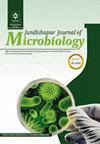Comparison of the Polymerase Chain Reaction Method with Serological Tests in the Diagnosis of Human Brucellosis
IF 0.5
4区 医学
Q4 MICROBIOLOGY
引用次数: 2
Abstract
Background: Brucellosis is a zoonotic disease with different clinical symptoms. Its early diagnosis is essential to prevent severe complications. Due to the limitations of serological diagnostic methods, the polymerase chain reaction (PCR) method has become important in the diagnosis of the disease. Objectives: Our study aimed to evaluate the PCR method in patients with suspected brucellosis and compare it with serological tests. Methods: This cross-sectional study was performed on 90 febrile patients with clinical features of brucellosis who were examined by an infectious disease specialist. A total of 90 serum samples were collected from the suspected brucellosis patients admitted to the hospital and were analyzed by serological (Rose Bengal) and PCR tests. Then, each method's results were recorded and compared with each other. Results: According to serological test results, 45 samples were negative, and 45 were positive. Then, among the serology-positive patients, all had positive PCR results. However, 40 out of 45 patients had a positive PCR test in serology-negative patients. According to this study, the sensitivity of PCR in diagnosing human brucellosis with the serology-positive test is 100%, and with the negative serology test is 88.9%. Therefore, the sensitivity of PCR is higher than that of serology tests in patients, which was 50% in this study. Conclusions: The PCR test can be a valuable diagnostic method for patients with negative serologic test results.聚合酶链反应法与血清学试验诊断人布鲁氏菌病的比较
背景:布鲁氏菌病是一种具有不同临床症状的人畜共患疾病。早期诊断对预防严重并发症至关重要。由于血清学诊断方法的局限性,聚合酶链式反应(PCR)方法在疾病诊断中变得重要。目的:本研究旨在评估PCR方法在疑似布鲁氏菌病患者中的应用,并将其与血清学检测进行比较。方法:对90例具有布鲁氏菌病临床特征的发热患者进行横断面研究。共从入院的疑似布鲁氏菌病患者中采集了90份血清样本,并通过血清学(玫瑰孟加拉)和PCR检测进行了分析。然后,记录每种方法的结果并相互比较。结果:血清学检测结果为阴性45例,阳性45例。然后,在血清学阳性患者中,所有患者的PCR结果均为阳性。然而,在血清学阴性的患者中,45名患者中有40人的PCR检测呈阳性。根据本研究,血清学阳性检测的PCR诊断人类布鲁氏菌病的敏感性为100%,血清学阴性检测的敏感性为88.9%。因此,PCR的敏感性高于本研究中50%的血清学检测。结论:对于血清学检测结果为阴性的患者,PCR检测是一种有价值的诊断方法。
本文章由计算机程序翻译,如有差异,请以英文原文为准。
求助全文
约1分钟内获得全文
求助全文
来源期刊

Jundishapur Journal of Microbiology
MICROBIOLOGY-
CiteScore
1.30
自引率
0.00%
发文量
56
审稿时长
6-12 weeks
期刊介绍:
Jundishapur Journal of Microbiology, (JJM) is the official scientific Monthly publication of Ahvaz Jundishapur University of Medical Sciences. JJM is dedicated to the publication of manuscripts on topics concerning all aspects of microbiology. The topics include medical, veterinary and environmental microbiology, molecular investigations and infectious diseases. Aspects of immunology and epidemiology of infectious diseases are also considered.
 求助内容:
求助内容: 应助结果提醒方式:
应助结果提醒方式:


